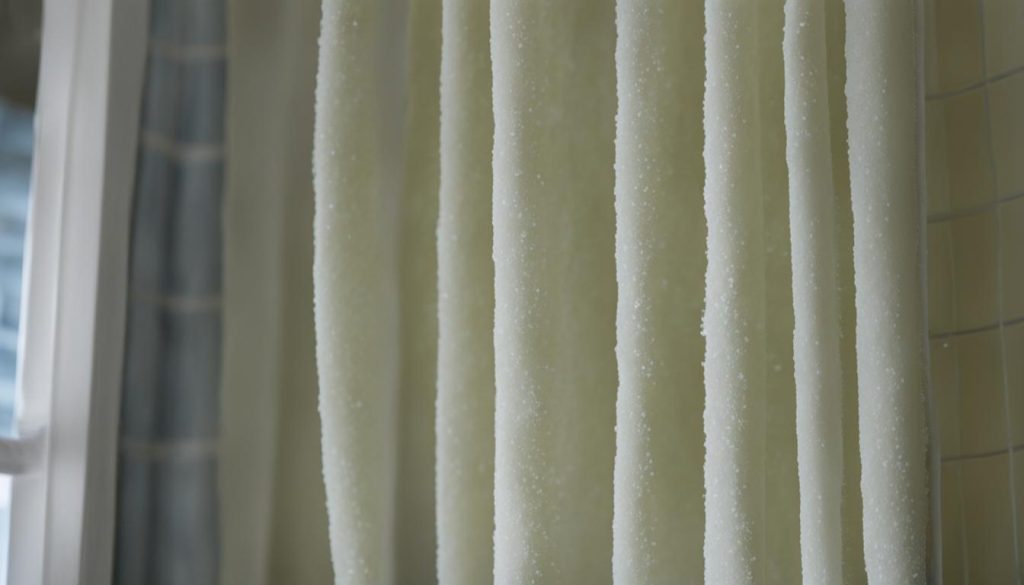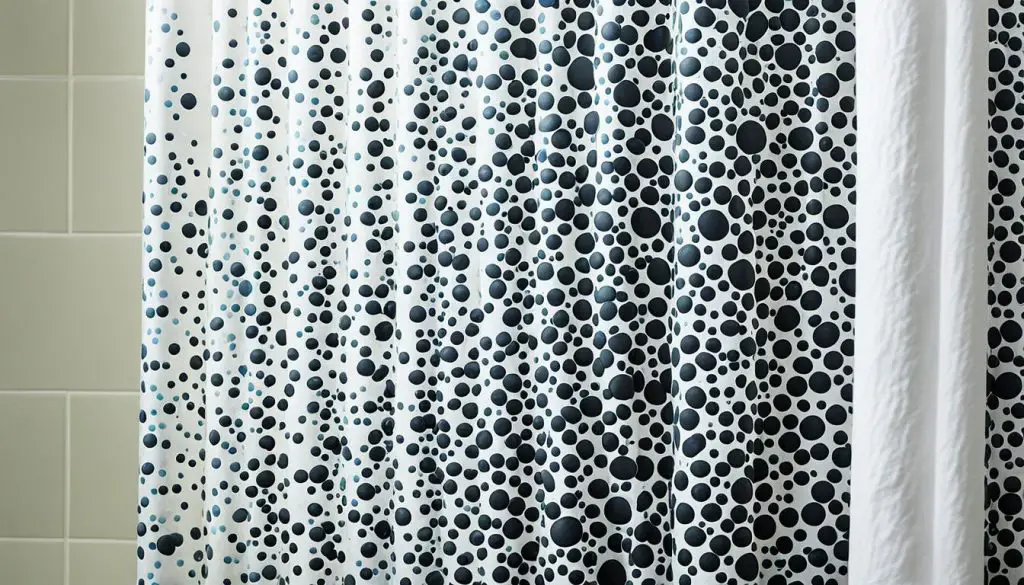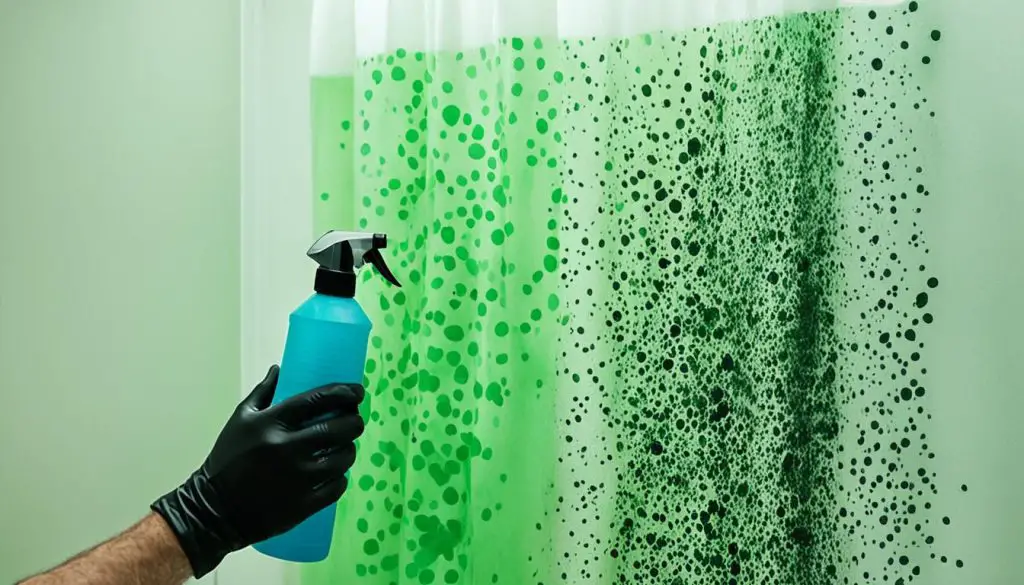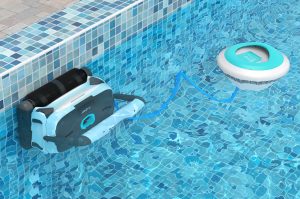Mold on a shower curtain not only looks unsightly but can also be detrimental to your health. However, there are several effective methods to remove mold from shower curtains, allowing you to maintain a clean and healthy shower space. Vinegar, baking soda, hydrogen peroxide, and bleach are all popular solutions for tackling mold on curtains. Additionally, implementing preventive measures can help prevent mold growth in the future.
Key Takeaways:
- Shower curtains can develop mold, which is unsightly and potentially harmful to health.
- Popular methods for removing mold from shower curtains include vinegar, baking soda, hydrogen peroxide, and bleach.
- Preventive measures such as improving ventilation and drying the curtain properly can help prevent mold growth.
- Be cautious when using vinegar on dark-colored fabrics, as it may cause fading and spotting.
- Baking soda can effectively remove black or pink stains left behind by mold.
Using Vinegar to Remove Mold
When it comes to mold removal, vinegar is a natural powerhouse that can effectively eliminate mold from your shower curtain. Distilled white vinegar is particularly effective in combating mold growth on shower curtains made of fabric or vinyl. Here’s how you can use vinegar to remove mold:
- Start by removing the shower curtain or liner from the hooks.
- Fill a large container or bathtub with undiluted vinegar.
- Submerge the curtain or liner in the vinegar and let it soak for at least one hour. Ensure that it is fully immersed in the vinegar solution.
- After the designated soaking time, remove the curtain and rinse it thoroughly with cold water to remove any remaining vinegar.
- Next, wash the curtain in cold water using regular laundry detergent or mild soap. Follow the care instructions of the curtain to avoid any damage.
- Finally, air-dry the curtain by hanging it back on the hooks or laying it flat on a clean, dry surface.
It’s important to note that vinegar may cause fading and spotting on dark-colored fabrics, so exercise caution and perform a spot test on a hidden area before applying vinegar liberally. If you notice any adverse effects, consider using an alternative method.
Using vinegar is an affordable and eco-friendly way to remove mold from your shower curtain. Give it a try and say goodbye to mold and mildew in your bathroom!
Using Baking Soda to Remove Mold
While baking soda alone may not kill mold spores, it is a powerful cleaner that can effectively remove black or pink stains left behind by mold. To use baking soda for mold removal, follow these steps:
- Create a paste by mixing baking soda with a small amount of water.
- Gently scrub the mold-stained areas of the shower curtain using a soft-bristled brush.
- Wash the curtain as usual and air-dry it.
Baking soda, also known as sodium bicarbonate, works as a mild abrasive and deodorizer, making it ideal for cleaning various surfaces, including fabric and vinyl.

Remember, prevention is key to maintaining a mold-free shower curtain. Regularly cleaning and drying the curtain, as well as promoting proper ventilation in the bathroom can help prevent mold from recurring. Read on, as in the next section we’ll explore other methods to remove mold from your shower curtain!
Other Methods to Remove Mold
When it comes to tackling mold on shower curtains, hydrogen peroxide and bleach are two effective methods worth considering.
- Hydrogen Peroxide: Hydrogen peroxide acts as a mild bleach that kills mold spores and removes stains. To use hydrogen peroxide for mold removal, dilute it if you’re cleaning a dark-colored fabric curtain to prevent bleaching. Apply the diluted hydrogen peroxide to the mold-affected areas and let it sit for around 15 minutes. Rinse the curtain thoroughly and air-dry.
- Bleach: Chlorine bleach is known for its fast and potent mold-killing properties. However, it can be harsh and should be used with caution. Mix one part bleach with three parts water, and then use a cloth or sponge to apply the solution to the mold spots. Allow the bleach mixture to sit for a few minutes before rinsing thoroughly. Remember to wear gloves and ensure proper ventilation during the bleach cleaning process. After rinsing, air-dry the curtain to avoid moisture buildup.
Both methods are effective in removing mold, but it’s important to take necessary precautions while using them.

| Mold Removal Method | Advantages | Disadvantages |
|---|---|---|
| Hydrogen Peroxide | – Mild bleach that kills mold spores – Removes stains – Safe for most fabrics and vinyl curtains |
– Requires dilution for dark-colored fabrics to prevent bleaching |
| Bleach | – Fast and effective mold removal – Kills mold spores – Widely available |
– Harsh on skin and respiratory system – Requires careful handling and proper ventilation – May damage certain fabrics and vinyl curtains if used undiluted |
Preventing Mold on Shower Curtains
To maintain a clean and mold-free shower curtain, it is crucial to implement preventive measures. One of the most effective ways to prevent mold growth is by increasing ventilation in your bathroom. Make sure to turn on the exhaust fan whenever you shower and open windows to allow air circulation.
Drying the vinyl liner thoroughly after each use is also essential. Use a towel to remove any moisture, as this helps inhibit mold growth. Avoid leaving the shower curtain bunched up, as it hinders proper drying and creates a damp environment where mold can thrive.
In addition to ventilation and drying, regular cleaning of the shower curtain is a preventive measure that should not be overlooked. Depending on the type of curtain you have, follow the manufacturer’s instructions for washing. Keeping it clean not only helps prevent mold but also removes any existing mildew or buildup.
FAQ
How can I remove mold from my shower curtain?
Mold can be removed from a shower curtain using various methods such as vinegar, baking soda, hydrogen peroxide, and bleach. These solutions effectively eliminate mold and maintain a clean and healthy shower space.
Can vinegar be used to remove mold from a fabric shower curtain?
Yes, vinegar is an effective and natural solution for eliminating mold on shower curtains. To use vinegar for mold removal, soak the curtain in undiluted vinegar for at least one hour, then wash it using regular laundry detergent and air-dry.
Is baking soda effective in removing mold stains from a shower curtain?
While baking soda alone may not kill mold spores, it is a powerful cleaner that can effectively remove black or pink stains left behind by mold. To use baking soda for mold removal, create a paste by mixing it with a small amount of water. Gently scrub the mold-stained areas of the curtain using a soft-bristled brush, then wash and air-dry it.






